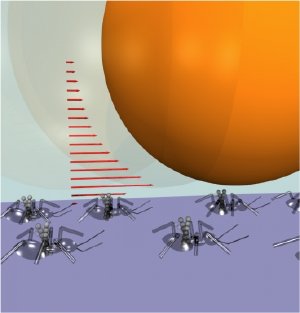Dec 14 2009
A new microscopic system devised by researchers in MIT's department of materials science and engineering, in collaboration with researchers in Germany and Boston University, could provide a novel method for moving tiny objects inside a microchip, and could also provide new insights into how cells and other objects are transported around within the body.
 Chains of superparamagnetic colloidal particles rotate to produce flows on length scales much larger than the chain dimensions, allowing them to behave like "micro-ants" that can move large particles. Photo - Image: Charles Sing
Chains of superparamagnetic colloidal particles rotate to produce flows on length scales much larger than the chain dimensions, allowing them to behave like "micro-ants" that can move large particles. Photo - Image: Charles Sing
Inside organs such as the trachea and the intestines, tiny hair-like filaments called cilia are constantly in motion, beating in unison to create currents that sweep along cells, nutrients, or other tiny particles. The new research uses a self-assembling system to mimic that kind of motion, providing a simple way to move particles around in a precisely controlled way.
Alfredo Alexander-Katz, Professor of Materials Science and Engineering, his doctoral student Charles Sing, and other researchers, devised a system that uses so-called superparamagnetic beads (tiny beads made of polymers with specks of magnetic material in them). Due to the heavy magnetic material content, these beads sink to the bottom of the sample. By applying a rotating magnetic field, which caused the beads to spontaneously form short chains which began spinning, they were able to create currents that could then carry along surrounding particles — even particles as much as 100 times larger than the beads themselves.
Alexander-Katz refers to the microscopic assembly of beads — each just a few microns (a millionth of a meter) in size — as “micro-ants,” because of their ability to move along while “carrying” objects so much larger than themselves. A paper describing the research will appear the week of Dec. 14 in the Proceedings of the National Academy of Sciences.
The new method could provide a simpler, less-expensive alternative to present microfluidic devices, a field that is still in its early stages of development. Now, such devices require precisely made channels, valves and pumps created using microchip manufacturing methods, in order to control the movement of fluids through them. But the new system could offer such precise control over the movement of liquids and the particles suspended in them that it may be possible to dispense with the channels and other plumbing altogether, controlling the movements entirely through variations in the applied magnetic field.
In short, software rather than hardware could control the chip's properties, allowing it to be instantly reconfigured through changes in the controlling software — an approach Alexander-Katz refers to as “virtual microfluidics.” This could reduce the cost and increase the flexibility of the devices, which might be used for such things as biomedical screening or the detection of trace elements for pollution monitoring or security screening. It might also provide even finer spatial control than can presently be achieved using conventional channels on chips.
Alexander-Katz says the work might also help scientists better understand the way cilia works, by providing a way to mimic their activity in the lab. “People are still trying to understand how you get hydrodynamic synchronization systems” of cilia in organisms. “This might be a way to test many of the theories.”
He says the way the chains of beads moved is a bit like a person trying to do cartwheels while standing on an icy surface. “As they rotate, they slip a bit,” he says, “but overall, they keep moving,” and this imparts a directional flow to the surrounding fluid.
Ultimately, such a system might someday even be developed to use in medical diagnostics, by allowing controlled delivery of particles inside the body to specifically targeted locations, for example while the patient is in a nuclear magnetic resonance (NMR) imaging system.